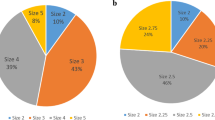Abstract
Background
Marital status is a commonly reported demographic variable in scientific literature. Numerous reports suggested difference in the medical outcomes of patients when stratified based on marital status. Although many reports suggested that married patient exhibit improved survival when compared to their counterparts, other reports could not replicate similar conclusions.
Purpose
determine whether marital status plays a role in the postoperative outcomes of elective abdominoplasty patients.
Methods
The medical records of all abdominoplasty patients operated by a single surgeon over the course of 20 years were reviewed. Information regarding the preoperative state of patients, surgical procedure, and postoperative outcomes was evaluated in respect to the patients marital status.
Results
Seven-hundred and twelve patients were included in this study, of whom 516 (%) were married. No difference in preoperative characteristics, medical background, surgical procedure or concomitant surgeries was found. Analysis of adverse events did not demonstrate a statistically significant association with marital status. Additionally, when all unwed patients were grouped together, the results did not differ.
Conclusion
Marital status does not play a critical role in the postoperative outcomes of patients undergoing elective abdominoplasties for cosmetic indications.
Level of Evidence III
This journal requires that authors assign a level of evidence to each article. For a full description of these Evidence-Based Medicine ratings, please refer to the Table of Contents or the online Instructions to Authors www.springer.com/00266.
Similar content being viewed by others
References
Skorochod R, Rysin R, Wolf Y (2023) Gender affirming surgery in non-binary patients: the importance of patient-centered care. J Plast Reconstr Aesthet Surg 84:176–181
Minehart RD, Bryant AS, Jackson J et al (2021) Racial/ethnic inequities in pregnancy-related morbidity and mortality. Obstet Gynecol Clin North Am 48(1):31–51
Skorochod R, Rysin R, Wolf Y (2023) Age-related outcomes of chest masculinization surgery: a single-surgeon retrospective cohort study. Plast Reconstr Surg Glob Open 11(2):e4799
Kmietowicz Z (2015) Being married is linked to better outcomes from cardiac surgery. BMJ 28(351):h5758
Gulack BC, Hale B, White WD et al (2017) Marriage and mortality after noncardiac surgery. J Surg Res 210:152–158
Manzoli L, Villari P, Pirone M, G, et al (2007) Marital status and mortality in the elderly: a systematic review and meta-analysis. Soc Sci Med 64(1):77–94
Sammon JD, Morgan M, Djahangirian O et al (2012) Marital status: a gender-independent risk factor for poorer survival after radical cystectomy. BJU Int 110(9):1301–1309
Matarasso A, Matarasso DM, Matarasso EJ (2014) Abdominoplasty: classic principles and technique. Clin Plast Surg 41(4):655–672
Neuman MD, Werner RM (2016) Marital status and postoperative functional recovery. JAMA Surg 151(2):194–196. https://doi.org/10.1001/jamasurg.2015.3240.PMID:26509594;PMCID:PMC4772863
Idler EL, Boulifard DA, Contrada RJ (2012) Mending broken hearts: marriage and survival following cardiac surgery. J Health Soc Behav 53(1):33–49. https://doi.org/10.1177/0022146511432342. (PMID: 22382719)
Ikeda A, Iso H, Toyoshima H et al (2007) Marital status and mortality among Japanese men and women: the Japan Collaborative Cohort Study. BMC Public Health 7(7):73. https://doi.org/10.1186/1471-2458-7-73.PMID:17484786;PMCID:PMC1871578
Sorlie DP, Backland E, Keller BJ (1995) US mortality by economic demographic, and social characteristics: the national longitudinal mortality study. Am J Public Health 85:949–956
Ben-Shlomo Y, Davey Smith G, Shipley M et al (1993) Magnitude and cause of mortality differences between married and unmarried men. J Epidemiol Community Health 47:200–205
Goldman N, Hu Y (1993) Excess mortality among the unmarried: a case study of Japan. Soc Sci Med 36:533–546
Hu Y, Goldman N (1990) Mortality differentials by marital status: an international comparison. Demography 27:233–250
DiMatteo MR (2004) Social support and patient adherence to medical treatment: a meta-analysis. Health Psychol 23(2):207–218
Iwashyna TJ, Christakis NA (2003) Marriage, widowhood, and health-care use. Soc Sci Med 57(11):1
Eng PM, Rimm EB, Fitzmaurice G et al (2002) Social ties and change in social ties in relation to subsequent total and cause-specific mortality and coronary heart disease incidence in men. Am J Epidemiol 155:700–709
Berkman LF, Glass T (2000) Social integration, social networks, social support, and health. In: Berkman LF, Kawachi I (eds) Social epidemiology. Oxford University Press, New York, NY, pp 137–173
Singh V, Fiedler B, Kugelman DN et al (2022) Effect of marital status on outcomes following total joint arthroplasty. Arch Orthop Trauma Surg 142(12):3651–3658
Lall AC, Schwarzman GR, Battaglia MR et al (2021) Effect of marital status on patient-reported outcomes following total hip arthroplasty: a matched analysis with minimum 2-year follow-up. Hip Int 31(3):362–368
Gatchel RJ, Mayer TG, Kidner CL, McGeary DD (2005) Are gender, marital status or parenthood risk factors for outcome of treatment for chronic disabling spinal disorders? J Occup Rehabil 15:191–201
Siva Kumar FD, Vaingankar JA, Sambasivam R et al (2019) Marital status and positive mental health of psychiatric outpatients. Ann Acad Med Singap 48(12):429–434 (PMID: 32112067)
Robertson NC (1974) The relationship between marital status and the risk of psychiatric referral. Br J Psychiatry 124(579):191–202
Broms U, Silventoinen K, Lahelma E et al (2004) Smoking cessation by socioeconomic status and marital status: the contribution of smoking behavior and family background. Nicotine Tob Res 6(3):447–455
Pennanen M, Broms U, Korhonen T et al (2014) Smoking, nicotine dependence and nicotine intake by socio-economic status and marital status. Addict Behav 39(7):1145–1151
Author information
Authors and Affiliations
Corresponding author
Additional information
Publisher's Note
Springer Nature remains neutral with regard to jurisdictional claims in published maps and institutional affiliations.
Rights and permissions
Springer Nature or its licensor (e.g. a society or other partner) holds exclusive rights to this article under a publishing agreement with the author(s) or other rightsholder(s); author self-archiving of the accepted manuscript version of this article is solely governed by the terms of such publishing agreement and applicable law.
About this article
Cite this article
Skorochod, R., Fainzilber-Goldman, Y., Shumsky, M. et al. What Role does Marital Status Play in the Outcome of Abdominoplasties? A Single-Surgeon Experience With 712 Cases. Aesth Plast Surg (2024). https://doi.org/10.1007/s00266-024-03898-2
Received:
Accepted:
Published:
DOI: https://doi.org/10.1007/s00266-024-03898-2




